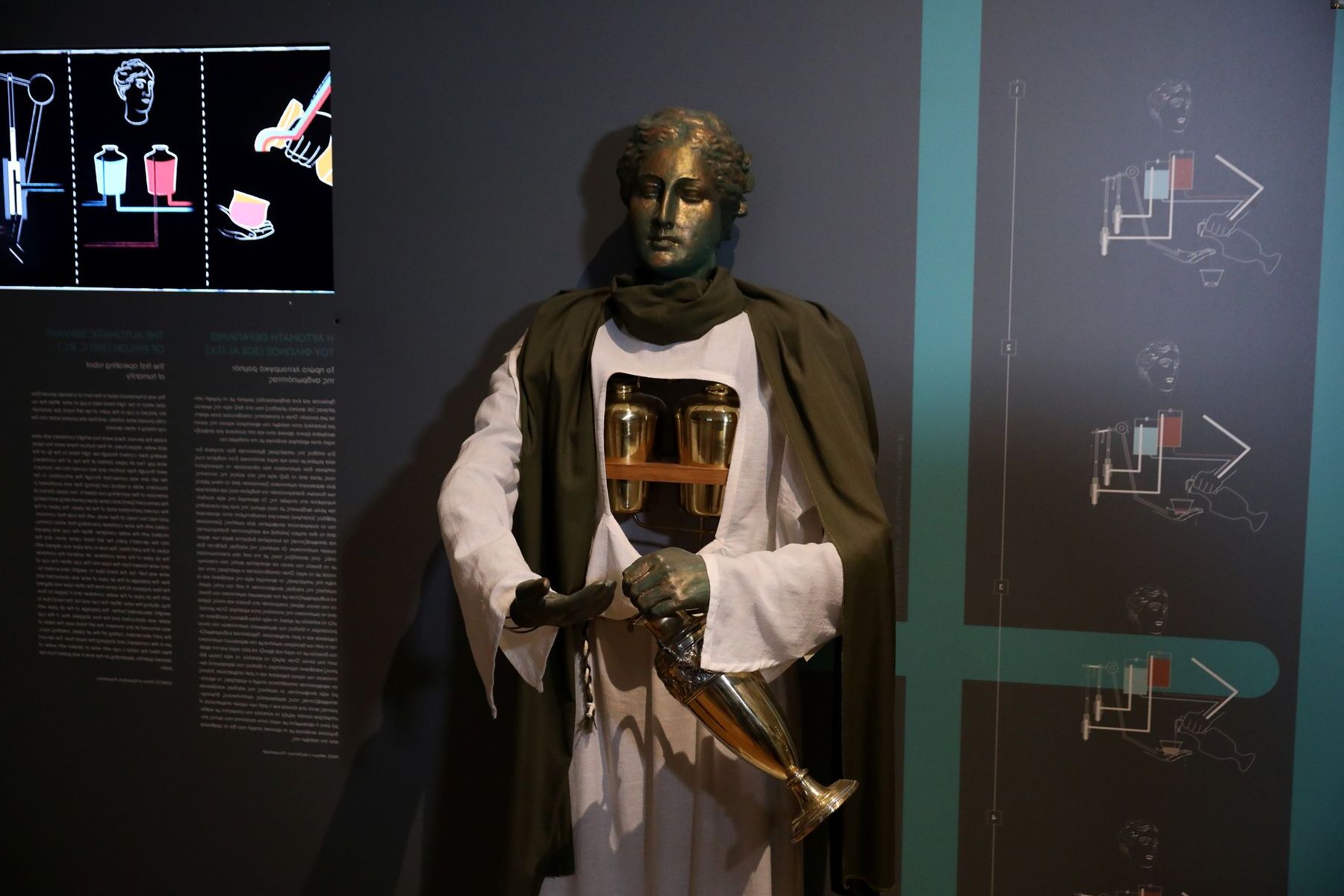
Did you know that ancient Greeks were pioneers in robotics? Long before modern technology, they crafted ingenious machines that mimicked life. From automated temples to self-moving carts, these early inventions showcased their incredible understanding of mechanics and engineering. Ancient Greek robotics combined art, science, and mythology, creating wonders that amazed their contemporaries. Imagine a world where statues could pour wine, doors opened by themselves, and mechanical birds sang. These marvels weren't just myths; they were real creations by brilliant minds like Hero of Alexandria. Dive into the fascinating world of ancient Greek robotics and discover how these early innovations laid the groundwork for today's technological advancements.
Key Takeaways:
- The ancient Greeks were more than philosophers and politicians; they were also early innovators in robotics, creating steam-powered devices, automatic servants, and even a mechanical bird that could fly.
- Greek robotics had a lasting impact on modern science and engineering, influencing fields such as robotic surgery, automated manufacturing, artificial intelligence, space exploration, and renewable energy systems.
Ancient Greek Robotics: A Glimpse into the Past
Ancient Greece wasn't just about philosophy and democracy. They also dabbled in robotics! Yes, you read that right. The Greeks were ahead of their time, creating mechanical wonders that still boggle minds today. Let's dive into some fascinating facts about ancient Greek robotics.
Early Innovations in Greek Robotics
The Greeks were pioneers in many fields, including robotics. Their early inventions laid the groundwork for future technological advancements.
- Hero of Alexandria was a Greek engineer who created the first known steam-powered device, the aeolipile. This invention is considered an early form of a steam engine.
- Archytas of Tarentum built a mechanical bird called "The Pigeon," which could fly using steam power. This is one of the earliest examples of a robot.
- Philo of Byzantium designed an automatic servant that could pour wine. This device used a complex system of levers and pulleys.
- Ctesibius of Alexandria invented the first known water clock, or clepsydra, which used water to measure time accurately.
- The Antikythera Mechanism is an ancient Greek analog computer used to predict astronomical positions and eclipses. It is considered one of the most sophisticated ancient technologies.
The Role of Mythology in Greek Robotics
Greek mythology often featured mechanical beings and automatons, reflecting the culture's fascination with robotics.
- Talos was a giant bronze automaton created by Hephaestus, the god of blacksmiths. Talos was designed to protect the island of Crete.
- Pandora was another creation of Hephaestus. She was an artificial woman made from clay, endowed with life by the gods.
- The Golden Maidens were mechanical servants created by Hephaestus to assist him in his workshop.
- Daedalus was a mythical inventor who created mechanical statues that could move independently.
- The Colossus of Rhodes was a massive statue that some believe had mechanical features, such as moving arms.
Practical Applications of Greek Robotics
The Greeks didn't just create robots for fun; they also found practical uses for their inventions.
- Automatic Doors were used in temples. These doors opened and closed using steam power, creating a sense of awe among worshippers.
- Hydraulic Automata were used in gardens to create moving statues and fountains, enhancing the aesthetic appeal.
- Theatre Automata were mechanical devices used in Greek plays to create special effects, such as moving scenery and sound effects.
- Military Applications included the use of mechanical devices like catapults and ballistae, which were more accurate and powerful than manual versions.
- Water Pumps designed by Ctesibius were used to irrigate fields and supply water to cities.
Influence on Later Technologies
The innovations of ancient Greek robotics had a lasting impact on future technological developments.
- Leonardo da Vinci was inspired by ancient Greek texts and designs, incorporating similar principles into his own inventions.
- The Industrial Revolution saw the re-emergence of steam power, a concept first explored by Hero of Alexandria.
- Modern Robotics owes a debt to ancient Greek engineers, who laid the groundwork for automated machines.
- Astronomical Instruments like the Antikythera Mechanism influenced the development of later devices used in navigation and astronomy.
- Automated Toys in the 18th and 19th centuries were inspired by ancient Greek automata, showcasing the enduring appeal of mechanical wonders.
Lesser-Known Greek Robotic Inventions
While some Greek inventions are well-known, others remain obscure but equally fascinating.
- The Automatic Temple Doors of Alexandria used a system of ropes and pulleys to open and close, creating an illusion of divine intervention.
- The Singing Birds of Philo were mechanical birds that could chirp using air pressure, delighting audiences with their lifelike sounds.
- The Self-Propelled Cart designed by Hero of Alexandria could move independently using a system of weights and gears.
- The Automatic Theatre created by Hero featured moving figures and scenery, providing entertainment and storytelling.
- The Water Organ invented by Ctesibius used water pressure to create music, an early example of a hydraulic instrument.
The Legacy of Greek Robotics
The legacy of ancient Greek robotics continues to inspire and amaze.
- Modern Engineers study ancient Greek texts to understand the principles behind their inventions.
- Museums around the world display replicas of Greek automata, showcasing their ingenuity.
- Educational Programs use ancient Greek robotics to teach students about engineering and technology.
- Documentaries and books explore the history and impact of Greek robotics, bringing these ancient inventions to a wider audience.
- Cultural References in movies and literature often draw on Greek mythology and robotics, highlighting their lasting influence.
Fun Facts about Greek Robotics
Let's wrap up with some fun and quirky facts about ancient Greek robotics.
- Hero's Vending Machine dispensed holy water when a coin was inserted, an early example of automated vending.
- The Automatic Wine Pourer by Philo could serve wine to guests, impressing them with its mechanical precision.
- The Mechanical Play by Hero featured a fully automated performance, complete with moving figures and sound effects.
- The Steam-Powered Engine by Hero was called the aeolipile, named after Aeolus, the god of wind.
- The Water Clock by Ctesibius was so accurate that it could measure time down to the minute.
The Impact of Greek Robotics on Modern Science
The influence of ancient Greek robotics extends far beyond their time, impacting modern science and engineering.
- Robotic Surgery techniques owe a debt to the precision and innovation of ancient Greek engineers.
- Automated Manufacturing processes draw on principles first explored by Greek inventors.
- Artificial Intelligence development is inspired by the concept of creating lifelike machines, a dream of the ancient Greeks.
- Space Exploration technology benefits from the mechanical principles laid down by Greek engineers.
- Renewable Energy systems, like wind and water turbines, have roots in ancient Greek inventions.
Greek Robotics in Popular Culture
Ancient Greek robotics continues to capture the imagination of people around the world.
- Movies like "Jason and the Argonauts" feature Talos, the giant bronze automaton.
- Books such as "The Iliad" and "The Odyssey" include references to mechanical beings and automatons.
- Video Games like "Assassin's Creed Odyssey" incorporate elements of Greek robotics and mythology.
- TV Shows often explore the myths and legends of Greek robotics, bringing these ancient stories to life.
- Art and Sculpture frequently depict Greek automata, celebrating their ingenuity and creativity.
Ancient Greek Robotics: A Glimpse into the Past
Ancient Greek robotics showcased the ingenuity and creativity of early inventors. From Hero of Alexandria's automated devices to Archytas' flying pigeon, these early machines laid the groundwork for modern robotics. They weren't just for show; many had practical uses in temples and theaters, enhancing religious ceremonies and performances. The Antikythera mechanism, often dubbed the first analog computer, highlights the advanced understanding of gears and astronomy. These innovations reflect a society deeply interested in technology and its potential applications. Understanding these ancient marvels gives us a greater appreciation for the roots of modern engineering and robotics. The legacy of Greek inventors continues to inspire today's engineers and scientists, reminding us that the quest for knowledge and innovation is timeless. Ancient Greek robotics, though primitive by today's standards, were groundbreaking in their time and remain a testament to human curiosity and ingenuity.
Frequently Asked Questions
Was this page helpful?
Our commitment to delivering trustworthy and engaging content is at the heart of what we do. Each fact on our site is contributed by real users like you, bringing a wealth of diverse insights and information. To ensure the highest standards of accuracy and reliability, our dedicated editors meticulously review each submission. This process guarantees that the facts we share are not only fascinating but also credible. Trust in our commitment to quality and authenticity as you explore and learn with us.


